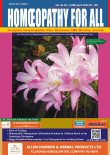Homoeopathic Approach to Treating Postpartum Psychiatric Disorders
Keywords:
Hippocrates, homoeopathicAbstract
Being a parent can be the most joyous period for the parents, especially for the women. But in some cases, it can be a nightmare due to depression. Back in the 4th century BC, Hippocrates described postpartum psychiatric disorders as lactational psychoses.1 The World Health Report 2005 states that women are 2-3 times more prone to experience anxiety and depression than men.2 50-80% of women experience some type of mood disturbance during their lying in period. These mood disturbances include anxiety, getting upset easily, feeling of being alone, fear of the unknown and/or feeling guilty, etc. Usually, such emotions fade down as the time passes but about 25% of women develop more significant symptoms like depression, anxiety, mood swings, etc. Among them, postpartum depression (PPD) itself constitutes up to 22% in India.3,4,5,6,7,8,9 It is known that the infant is affected with such psychiatric disorders of the mother. They may influence the infant feeding outcomes and, thus, affect the growth of the infant adversely.10,11 The exact cause of postpartum psychiatric disorders is not known but some evidence suggests that hormonal changes can be a causative factor.12 Apart from it, physical changes, personal and family history of depression, and the stress of caring for a new baby could be risk factors. It’s well known that conventional treatment has harmful effects both short-term and long term depending on the drug. On the other hand, homoeopathic medicines are safe and effective for postpartum psychiatric disorders. In this article, we have discussed how postpartum psychiatric disorders can well be managed with homoeopathy with repertorial analysis of symptoms and their indicated homoeopathic remedies with peculiar individualistic keynote symptoms.
Downloads
References
Riecher-Rössler A, Steiner M (eds): Perinatal Stress, Mood and Anxiety Disorders. From Bench to Bedside. BiblPsychiatr. Basel, Karger, 2005, No 173, pp 1-5 (DOI:10.1159/ 000087441).
The World Health Report 2005. Make Every Mother and Child Count. Chapter. 4. Attending to 136 Million Births, Every Year. p. 61- 77. Available from: http://www. who. int/whr/2005/chap4-en.pdf. [Last accessed on 2008 Jul 05].
Navarro P García-Esteve L Ascaso Cetal. . Non-psychotic psychiatric disorders after childbirth: prevalence and comorbidity in a community sample. J Affect Disord2008;109: 171–6.
Beck CT. Postpartum depression: it isn’t just the blues. Am J Nurs2006;106:40–50.
Chandran, M., Tharyan, P., Muliyil, J., & Abraham, S. (2002). Post partum depression in a cohort of women from a rural area of Tamil Nadu, India: Incidence and risk factors. British Journal of Psychiatry, 181(6), 499-504. doi:10.1192/bjp.181.6.499
Fisher J Cabral de Mello M Patel V et al.. Prevalence and determinants of common perinatal mental disorders in women in low and lower-middle-income countries: a systematic review. Bull World Health Organ 2012 ;90 : 139G–49G .
Upadhyay RP, Chowdhury R, Aslyeh Salehi, et al. Postpartum depression in India: a systematic review and meta-analysis. Bull World Health Organ.2017;95 (10):706-717C. doi:10.2471/ BLT.17. 192237
Hegde, Supriya and Latha, KS and Bhat, Sripathy M and Sharma, PSVN and Kamath, Asha (2012) Postpartum Depression: Prevalence and Associated Factors among Women in India.Journal of
Women ‘s Health, Issues and Care, 1 (1). pp. 1-7.
Himadri L. Patel, Jaishree D.
Ganjiwale, Archana S. Nimbalkar, Shashi N. Vani, Rohitkumar Vasa, Somashekhar M. Nimbalkar, Characteristics of Postpartum Depression in Anand District, Gujarat, India, Journal of Tropical Pediatrics, Volume 61, Issue 5, October 2015, Pages 364–369, https://doi.org/10.1093/tropej/ fmv046
Desai N Mehta R Ganjiwale J. Validation of Gujarati version of Edinburg post natal depression scale among women within their first post partum year. Indian J Soc Psychiatry 2011;27:16–23.
Desai ND Mehta RY GanjiwaleJ . Study of prevalence and risk factors of postpartum depression. Natl J Med Res 2012 ;2 :2249 –95 .
Schiller CE, Meltzer-Brody S, Rubinow DR (February 2015). “The role of reproductive hormones in postpartum depression”. CNS Spectrums. 20 (1): 48–59. doi:10.1017/S1092852914 000480. PMC 4363269. PMID 25263255
O’Hara MW, Zekoski EM, Philips LH, Wright EJ. Controlled prospective study of postpartum mood disorders: comparison of childbearing and nonchildbearing women. J Abnorm Psychol. 1990;99:3–15
Buist A. Perinatal depression, assessment and management. Aust Fam Physician. 2006;35:670–673.
Patel M, Bailey RK, Jabeen S, Ali S, Barker NC, Osiezagha K. Postpartum depression: a review. J Health Care Poor Underserved. 2012;23:534–542.
Murray L, Cooper P. Effects of postnatal depression on infant development. Arch Dis Child. 1997 Aug;77(2):99–101.
Sit D, Rothschild AJ, Wisner KL. A review of postpartum psychosis. J Womens Health. 2006;15:352–368.
The Boston Women’s Health Book Collective: Our Bodies Ourselves, pages 489–491, New York: Touchstone Book, 2005
WebMD: Understanding Post Partum Depression “The Basics of
Postpartum Depression”. Archived from the original on 2015-04-15. Retrieved 2015-04-09.
Depression among Women | Depression | Reproductive Health | CDC”. www.cdc.gov. Archived
from the original on 2017-04-16. Retrieved 2017-04-15
W. Boericke, New Manual of Homoeopathic Materia Medica & Repertory [with Relationship of Remedies], Second Re-Augmented & Revised Edition Based on Ninth Edition, Reprint Edition 2002, B. Jain Publishers, New Delhi.
J. H. Clarke, Dictionary of Practical Materia Medica, Reprint Edition 1992, B. Jain Publishers, New Delhi.
Andrew Chevallier, The Encyclopedia of Medicinal Plants, 1st Edition, 1996, Dorling Kindersley, London.
Dr. P. N. Varma, et al., A Compendium of Rare and Clinically Established Mother Tinctures, 4th Edition, Dr. Willmar Schwabe India Pvt. Ltd., A-36, Sector 60, Noida.
Mrs. Margaret Grieve, A Modern Herb, ISBN: 0486227987 & 0486227995.
Hering’s guiding symptoms of our Materia Medica By Calvin B. Knerr, M. D. B Jain Publishers Pvt Ltd; New Delhi.
Dr. Baberjea S. K. Miasmatic prescribing, Second edition. Allen College of Homoeopathy, 382, Baddow Road, Grear Baddow, Chelmsford, Essex CM2 9RA, England.




